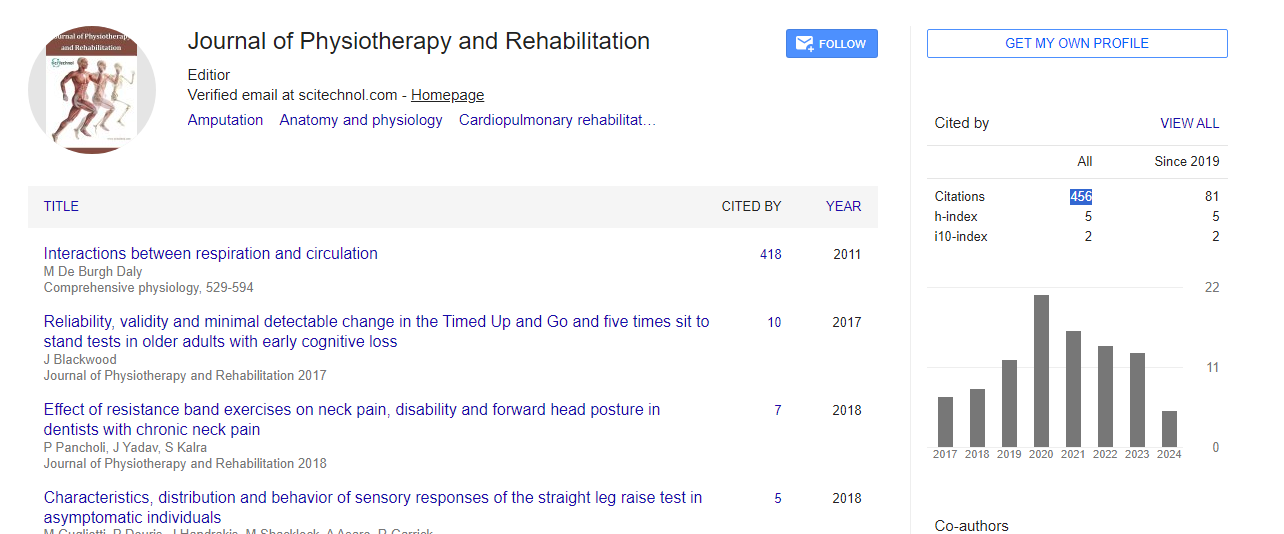Commentary, J Physiother Rehabi Vol: 8 Issue: 4
Impact of Assistive Technologies and Adaptive Equipment on Daily Living for Individuals with Spina Bifida
Bisen Levy*
1Department of Physiotherapy, University of Parma, Parma, Italy
*Corresponding Author: Bisen Levy,
Department of Physiotherapy, University of
Parma, Parma, Italy
E-mail: levbis@en.edu.it
Received date: 23 July, 2024, Manuscript No. JPTR-24-147318
Editor assigned date: 25 July, 2024, PreQC No. JPTR-24-147318 (PQ);
Reviewed date: 08 August, 2024, QC No. JPTR-24-147318
Revised date: 15 August, 2024, Manuscript No. JPTR-24-147318 (R);
Published date: 22 August 2024, DOI: 10.4172/JPTR.1000174.
Citation: Levy B (2024) Impact of Assistive Technologies and Adaptive Equipment on Daily Living for Individuals with Spina Bifida. J Physiother Rehabi 8:4.
Description
Spina bifida is a neural tube defect that occurs when the spinal column fails to close completely during fetal development. This condition can result in a range of physical and neurological impairments including motor dysfunction, sensory loss and mobility challenges. For individuals with spina bifida assistive technologies and adaptive equipment play a important role in enhancing daily living and improving overall quality of life. Mobility aids including wheelchairs, walkers and scooters are essential for individuals with spina bifida particularly those with significant lower limb involvement. Wheelchairs both manual and powered provide critical support for mobility and independence. Powered wheelchairs in particular offer increased fast moving and can reduce the physical strain on users. Walkers and canes are also used by individuals with partial mobility to assist with balance and support during walking. These mobility aids enable individuals to navigate their environments more effectively participate in daily activities and maintain a higher level of independence.
Adaptive seating systems and positioning equipment are designed to address the unique needs of individuals with spina bifida who may experience difficulties with posture, pressure relief and comfort. Customizable wheelchair seating systems can provide proper support and alignment reducing the risk of pressure and musculoskeletal problems. Positioning devices such as specialized cushions and backrests help maintain optimal body alignment and prevent complications related to poor posture. By improving comfort and support these tools enhance the user's ability to engage in various activities and reduce the risk of secondary health issues. Adaptive equipment for daily living aids individuals with spina bifida in performing everyday tasks more independently. Tools such as modified utensils adaptive kitchen appliances and dressing aids are designed to accommodate physical limitations and promote selfsufficiency. Dressing aids such as button hooks and zipper pulls assist with dressing and undressing reducing reliance on caregivers. These aids are important for enhancing independence and enabling individuals to manage personal care and household tasks.
For individuals with spina bifida who may experience speech or communication challenges, Augmentative and Alternative Communication (AAC) devices offer valuable support. AAC devices range from simple picture boards to smooth speech generating devices. These tools enable individuals to express their needs participate in conversations and engage in social interactions. By facilitating communication, AAC devices help improve social integration, reduce frustration and enhance overall quality of life.
Conclusion
Assistive technologies and adaptive equipment have a profound impact on daily living for individuals with spina bifida. These tools enhance mobility, comfort and independence enabling individuals to participate more fully in everyday activities and improve their overall quality of life. As technology continues to advance ongoing innovations and improvements in assistive devices will further support individuals with spina bifida helping them lead more independent and fulfilling lives. The integration of these tools into daily life represents a significant step towards greater accessibility and autonomy for those affected by this condition.
 Spanish
Spanish  Chinese
Chinese  Russian
Russian  German
German  French
French  Japanese
Japanese  Portuguese
Portuguese  Hindi
Hindi 